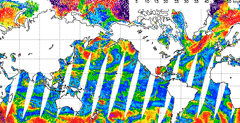|
|

|
|
|
Example image of global wind speeds over the ocean, measured from the QuikSCAT satellite.
Click the image for more information.
|

|
|
There are only 4 properties that a satellite can directly measure over the ocean:
- How far away is the water surface?
- How rough is the surface?
- What color is the water?
- What is the water temperature?
Marine scientists use these four basic types of data to measure and interpret a
wide range of properties about the ocean environment, such as:
- Sea surface height (sea level)
- Speed and direction of ocean currents
- Wave height, length, and direction
- Wind speed and direction
- Bathymetry (sea floor topography)
- Oceanographic features: eddies, temperature fronts, tidal fronts, shearing, etc.
- Air-sea fluxes (Energy: heat, water vapor - evaporation, light, momentum, gases)
- Turbidity (how clear the water is)
- Suspended sediment (soil particles floating in the water)
- Dissolved organic matter (usually pollutants or tannic acid from forests)
- Chlorophyll
- Primary production
For more information about how satellites measure these properties,
please see our Resources section. For the Coral Reef Watch
applications in the rest of this tutorial, we will focus on ocean temperature.
(top)
|
|
